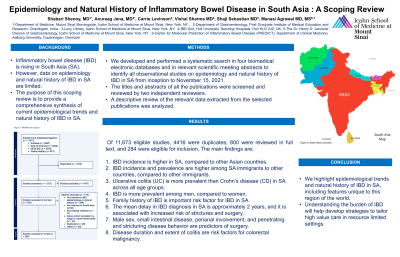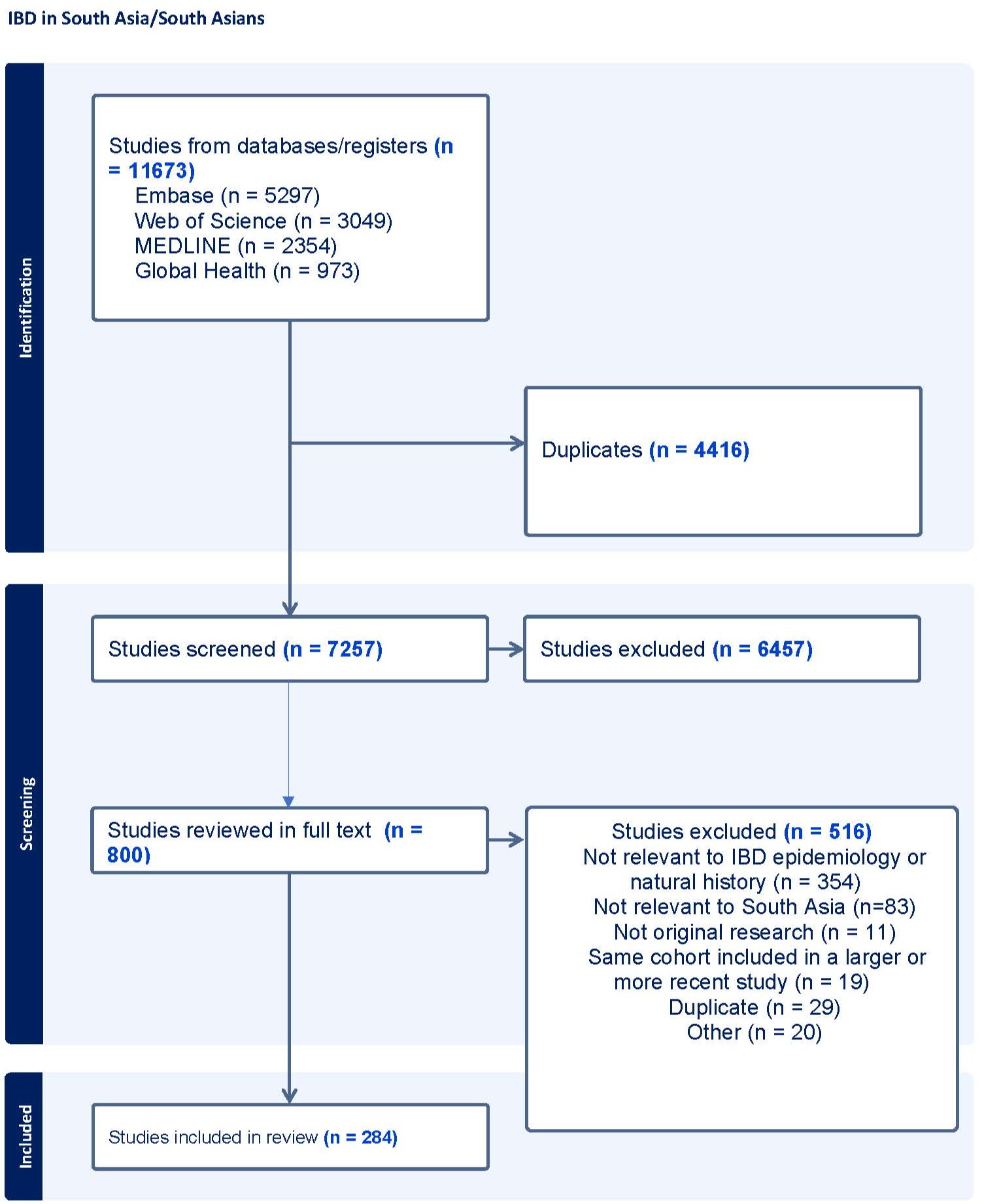Monday Poster Session
Category: IBD
P2175 - Epidemiology and Natural History of Inflammatory Bowel Disease in South Asia: A Scoping Review
Monday, October 23, 2023
10:30 AM - 4:15 PM PT
Location: Exhibit Hall

Has Audio
- SS
Shabari M. Shenoy, MBBS
Mount Sinai Morningside and Mount Sinai West Hospitals, Icahn School of Medicine at Mount Sinai
New York, NY
Presenting Author(s)
Shabari M. Shenoy, MBBS1, Anuraag Jena, MBBS2, Carrie Levinson, MS3, Vishal Sharma, MBBS2, Shaji Sebastian, MD4, Manasi Agrawal, MD, MS3
1Mount Sinai Morningside and Mount Sinai West Hospitals, Icahn School of Medicine at Mount Sinai, New York, NY; 2Postgraduate Institute of Medical Education and Research, Chandigarh, Chandigarh, India; 3Icahn School of Medicine at Mount Sinai, New York, NY; 4Hull University Teaching Hospitals, Hull, England, United Kingdom
Introduction: Inflammatory bowel disease (IBD) is rising in South Asia (SA). However, data on epidemiology and natural history of IBD in SA are limited. The purpose of this scoping review is to provide a comprehensive synthesis of current epidemiological trends and natural history of IBD in SA.
Methods: We developed and performed a systematic search in four biomedical electronic databases and in relevant scientific meeting abstracts to identify all observational studies on epidemiology and natural history of IBD in SA from inception to November 15, 2021. The titles and abstracts of all the publications were screened and reviewed by two independent reviewers. A descriptive review of the relevant data extracted from the selected publications was analyzed.
Results: Of 11,673 eligible studies, 4416 were duplicates, 800 were reviewed in full text, and 284 were eligible for inclusion. IBD incidence is higher in SA compared to other Asian countries. Similarly, IBD incidence and period prevalence are higher among SA immigrants compared to other immigrants. Ulcerative colitis (UC) is more prevalent than Crohn’s disease (CD) in SA across all age groups, and among women, compared to men. Family history of IBD is an important risk factor for IBD in SA. The mean delay in IBD diagnosis in SA is 2 years, and it is associated with increased risk of strictures and surgery. Male sex, small intestinal disease, perianal involvement, and penetrating and stricturing disease behavior are predictors of surgery. Disease duration and extent of colitis are risk factors for colorectal malignancy.
Discussion: This comprehensive review highlights the current epidemiological trends and unique characteristics of IBD in South Asia. Understanding the burden of IBD will help develop strategies to tailor high value care in resource limited settings.

Disclosures:
Shabari M. Shenoy, MBBS1, Anuraag Jena, MBBS2, Carrie Levinson, MS3, Vishal Sharma, MBBS2, Shaji Sebastian, MD4, Manasi Agrawal, MD, MS3. P2175 - Epidemiology and Natural History of Inflammatory Bowel Disease in South Asia: A Scoping Review, ACG 2023 Annual Scientific Meeting Abstracts. Vancouver, BC, Canada: American College of Gastroenterology.
1Mount Sinai Morningside and Mount Sinai West Hospitals, Icahn School of Medicine at Mount Sinai, New York, NY; 2Postgraduate Institute of Medical Education and Research, Chandigarh, Chandigarh, India; 3Icahn School of Medicine at Mount Sinai, New York, NY; 4Hull University Teaching Hospitals, Hull, England, United Kingdom
Introduction: Inflammatory bowel disease (IBD) is rising in South Asia (SA). However, data on epidemiology and natural history of IBD in SA are limited. The purpose of this scoping review is to provide a comprehensive synthesis of current epidemiological trends and natural history of IBD in SA.
Methods: We developed and performed a systematic search in four biomedical electronic databases and in relevant scientific meeting abstracts to identify all observational studies on epidemiology and natural history of IBD in SA from inception to November 15, 2021. The titles and abstracts of all the publications were screened and reviewed by two independent reviewers. A descriptive review of the relevant data extracted from the selected publications was analyzed.
Results: Of 11,673 eligible studies, 4416 were duplicates, 800 were reviewed in full text, and 284 were eligible for inclusion. IBD incidence is higher in SA compared to other Asian countries. Similarly, IBD incidence and period prevalence are higher among SA immigrants compared to other immigrants. Ulcerative colitis (UC) is more prevalent than Crohn’s disease (CD) in SA across all age groups, and among women, compared to men. Family history of IBD is an important risk factor for IBD in SA. The mean delay in IBD diagnosis in SA is 2 years, and it is associated with increased risk of strictures and surgery. Male sex, small intestinal disease, perianal involvement, and penetrating and stricturing disease behavior are predictors of surgery. Disease duration and extent of colitis are risk factors for colorectal malignancy.
Discussion: This comprehensive review highlights the current epidemiological trends and unique characteristics of IBD in South Asia. Understanding the burden of IBD will help develop strategies to tailor high value care in resource limited settings.

Figure: PRISMA Flow Diagram: Epidemiology and Natural History of IBD in South Asia
Disclosures:
Shabari Shenoy indicated no relevant financial relationships.
Anuraag Jena indicated no relevant financial relationships.
Carrie Levinson indicated no relevant financial relationships.
Vishal Sharma indicated no relevant financial relationships.
Shaji Sebastian indicated no relevant financial relationships.
Manasi Agrawal indicated no relevant financial relationships.
Shabari M. Shenoy, MBBS1, Anuraag Jena, MBBS2, Carrie Levinson, MS3, Vishal Sharma, MBBS2, Shaji Sebastian, MD4, Manasi Agrawal, MD, MS3. P2175 - Epidemiology and Natural History of Inflammatory Bowel Disease in South Asia: A Scoping Review, ACG 2023 Annual Scientific Meeting Abstracts. Vancouver, BC, Canada: American College of Gastroenterology.
